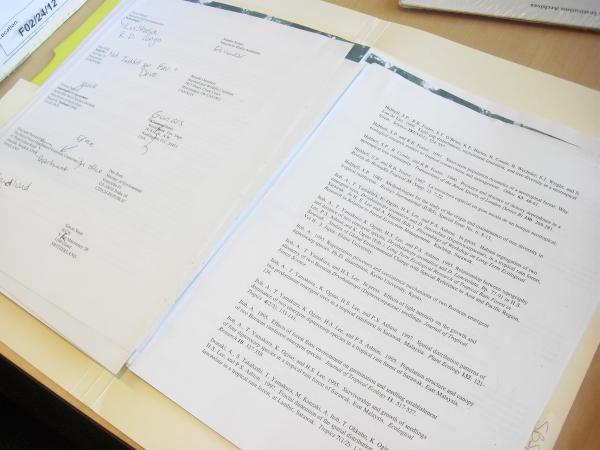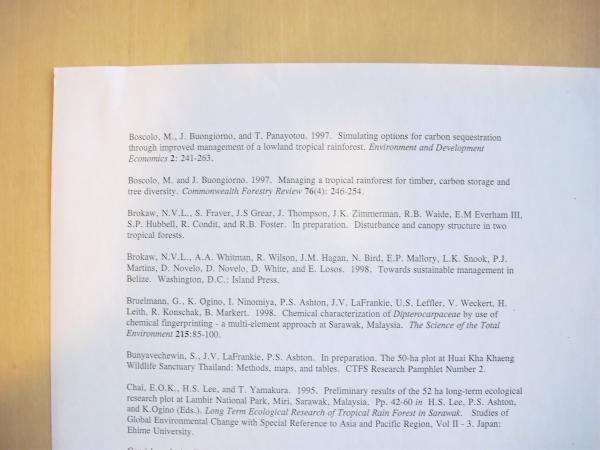Forests operate on a spatial and temporal scale that demands wide-ranging and long-term observations in order to see change. Taking a snapshot for one day, or in one hectare, confuses the immediate moment with the larger reality. Recognizing this, ForestGEO takes a different approach. ForestGEO is a Smithsonian-led network of researchers and large-scale, long-term research sites in twenty-seven countries. Over the last three decades, field crews at ForestGEO research sites have collected copious amounts of data that reveal the dynamic nature of forests.
This past summer I began researching ForestGEO’s organizational history at the Archives. Certain themes persisted over the years: a commitment to capacity building, long-standing partnerships with researchers and institutions, and a precedent of high-quality data collection. I was also intrigued to find an earlier emphasis on interdisciplinary and applied scholarship. Where current articles have examined functional traits, spatial distribution, and statistical methods, older pamphlets and newsletters consistently spoke to the need for a holistically-informed approach to the sustainable management of forests.
I recently went to the Archives to collect images for a forthcoming history page on the ForestGEO website. There were specific documents that I had seen before and planned to return to, but I also had a shortlist of promising folder titles that I was keen to pursue. And that’s when I stumbled upon it—it being “Bibliography: Publications Directly Resulting from Project Research.” Printed in July 1999 on scrap paper with our old letterhead, this fourteen-page document held the promise of filling gaps in our publications database. Any text that utilizes ForestGEO data is welcome to join this repository; identifying all such articles is an ongoing task.

Sometimes principal investigators of ForestGEO sites reach out to staff to share a new article. Other times, I discover one through a Twitter mention. And then in other instances, it’s the magic of Google Scholar recommendations that alerts me to another piece of research that has used ForestGEO plot data. With nearly thirty years as a network, ForestGEO data has been central to more than 1,000 publications, but our publications database didn’t start tracking them until the early 2000s. We had records for a handful of early research papers but suspected that there were others we didn’t know about and, consequently, wouldn’t be able to recover for our database.
Which brings us back to the Archives. Upon finding the bibliography, I had visions of rescuing early papers from analog invisibility. Indeed, in the following weeks I was able to cross-check the bibliography with our publications, and add over forty publications to the database. What particularly piqued my interest, though, was the inclusion of articles from journals like Environment and Development Economics, Land Economics, and Economic Botany. Overwhelmingly, ForestGEO papers cover topics of ecology. That has been, and will continue to be, the bread and butter of ForestGEO. But in a different historical moment—in a younger organizational self—ForestGEO publications included conversations between biologists, economists, and anthropologists cumulatively seeking to understand how forests work and how they could be sustainably managed.

I went to the Archives to research our history, and in doing so I found some very practical help in meeting my responsibility to maintain accurate records of ForestGEO publications. ForestGEO plot data seeks to capture change over time. The way that we, as an organization, have engaged with data has also changed, and the Archives has helped me to see that.
Related Collections
- Smithsonian Tropical Research Institute, Center for Tropical Forest Science, Program Records, 1980-2005, Accession 08-097, Smithsonian Institution Archives
- Smithsonian Tropical Research Institute, Center for Tropical Forest Science, Inside CTFS, 1994-2004, Accession 12-066, Smithsonian Institution Archives
Related Resources
- “How to Fit a Forest in Five Boxes” by Megan Raby, The Bigger Picture, Smithsonian Institution Archives
Produced by the Smithsonian Institution Archives. For copyright questions, please see the Terms of Use.

Leave a Comment